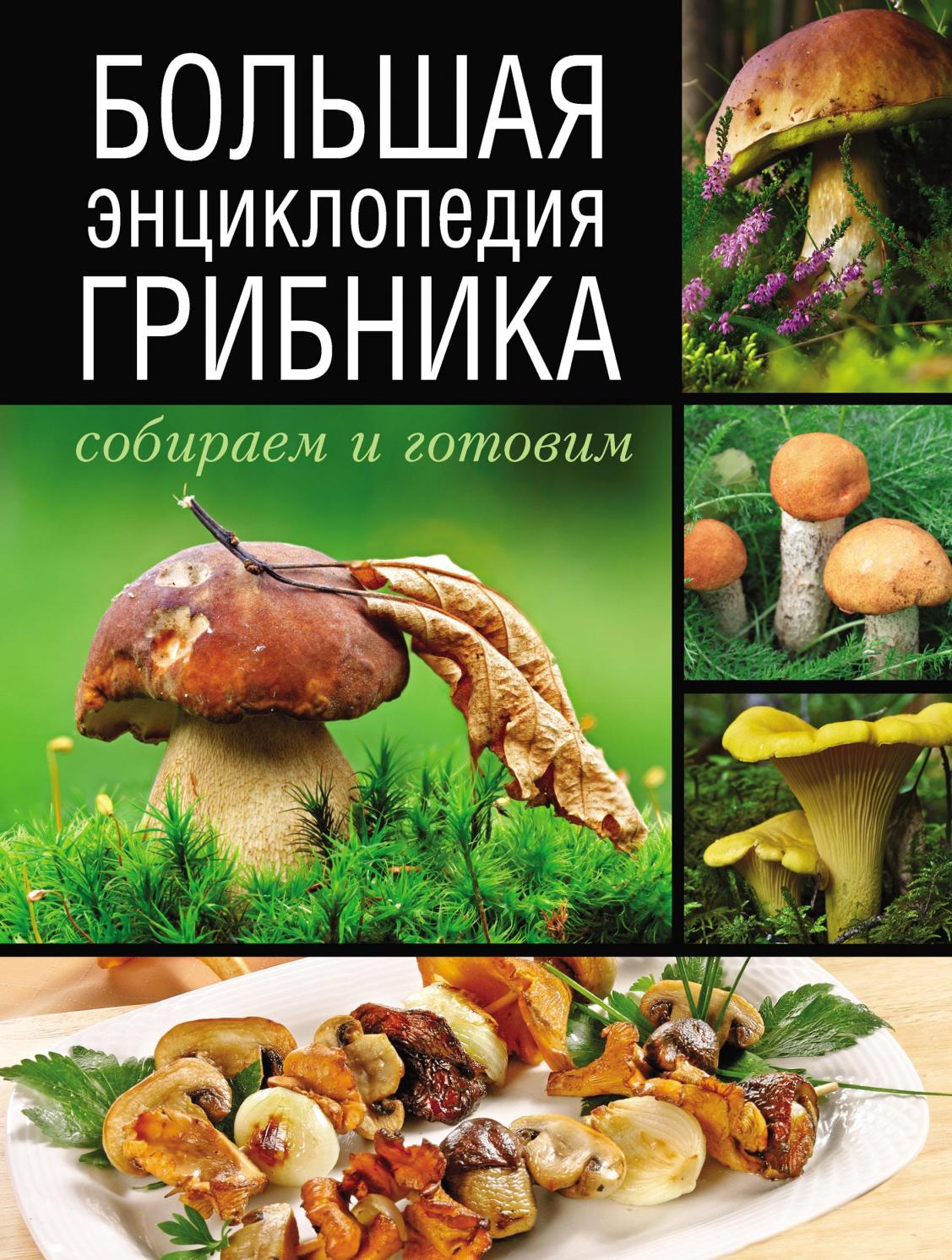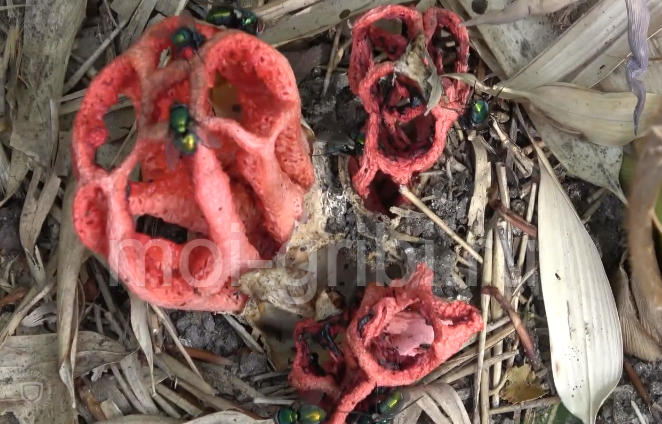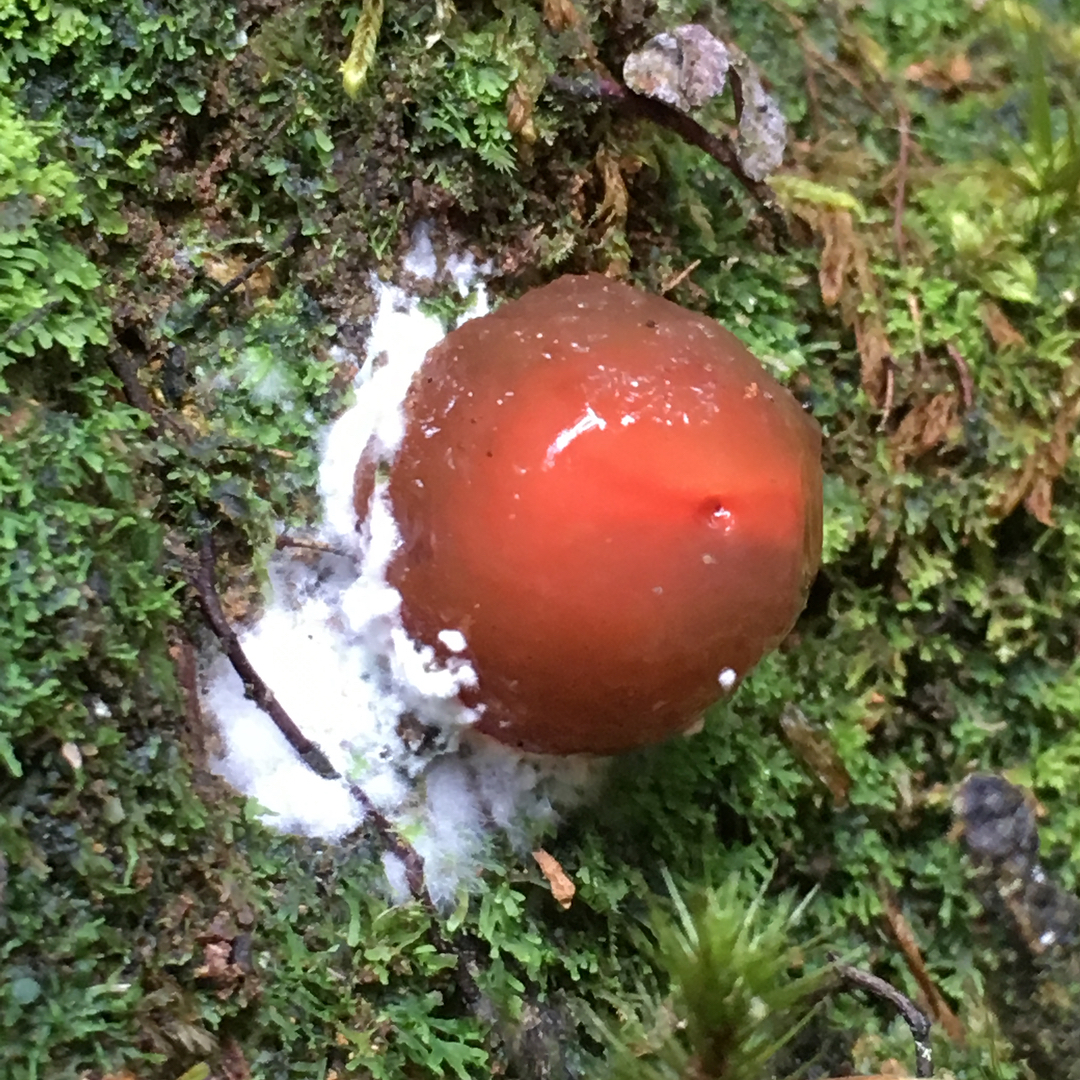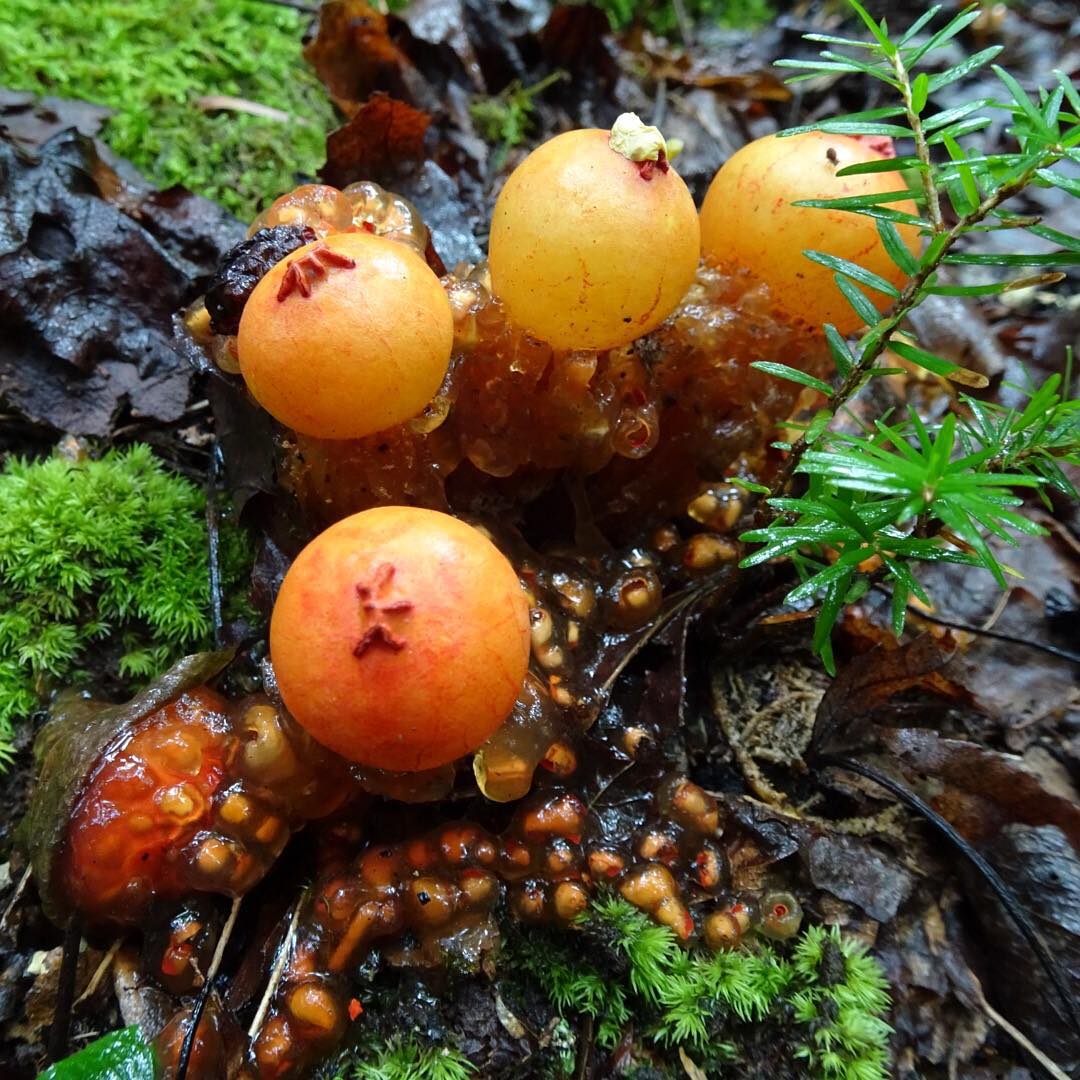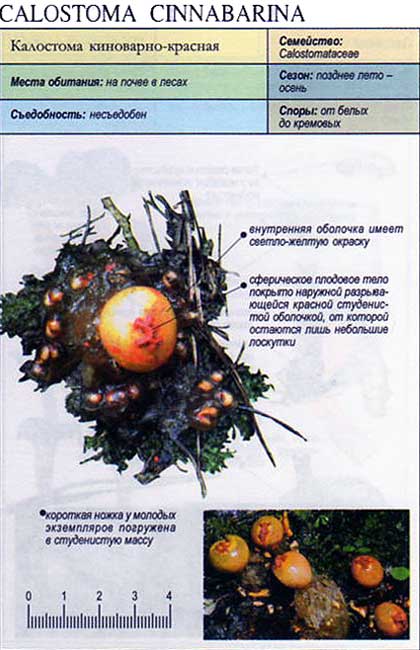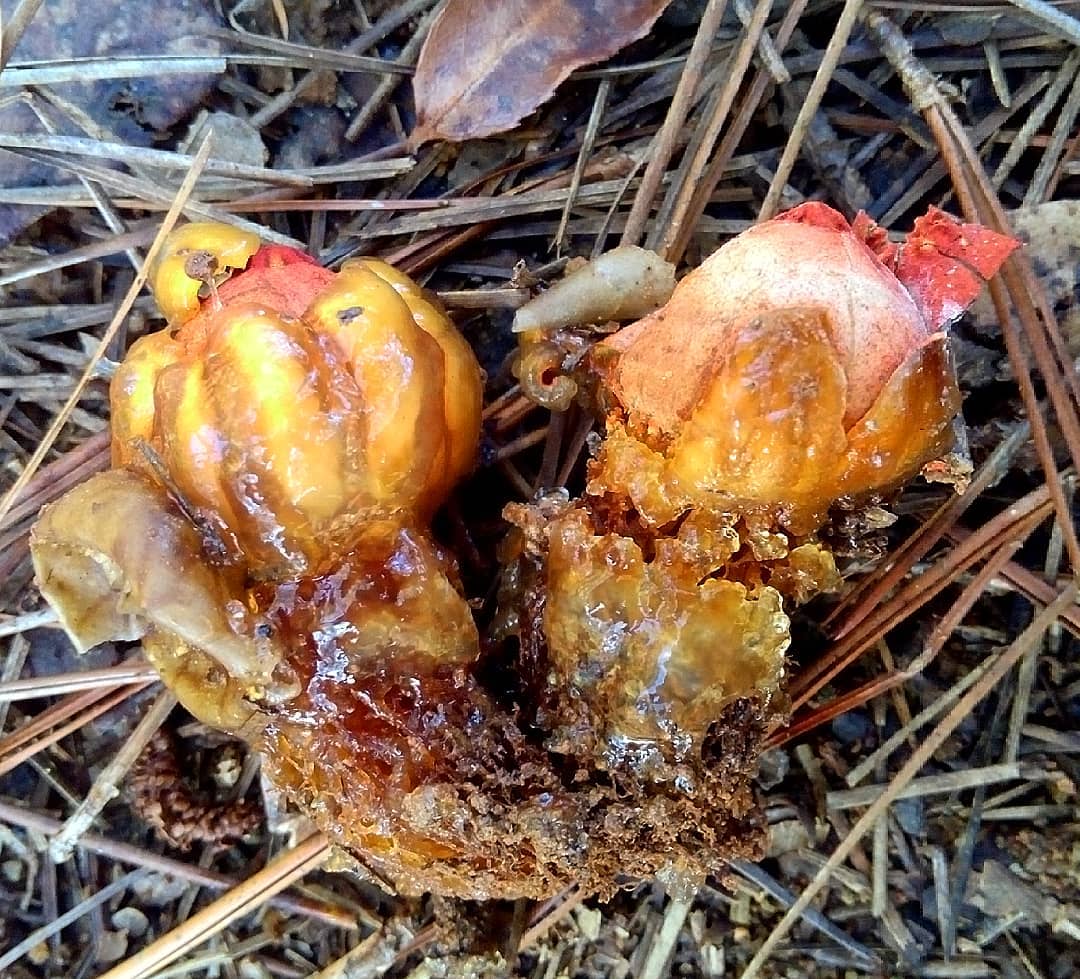Notes (edit)
- Castro-Mendoza, E .; Miller Jr, O.K .; Stetler, D.A. Basidiospore wall ultrastructure and tissue system morphology in the genus Calostoma in North America // Mycologia. - Mycological Society of America, 1983. - T. 75, No. 1. - S. 36-45.
- Atkinson, G.F. Studies of American fungi. Mushrooms, edible, poisonous, etc. - Ithaca, N.Y .: Andrus & Church, 1901. - S. 322 .-- p. 212-213.
- Andrew W. Wilson, Erik A. Hobbie, and David S. Hibbett. The ectomycorrhizal status of Calostoma cinnabarinum determined using isotopic, molecular, and morphological methods // Canadian Journal of Botany. - NRC Research Press, 2007. - T. 85, No. 4. - S. 385–393.
- Dumont, K.P. & Umaña, M.I. Los hongos de Colombia - V. Laterna triscapa y Calostoma cinnabarina en Colombia // Caldasia. - 1978. - T. 12, No. 58. - S. 349-352.
- Bi Zhishu, Guoyang Zheng, Li Taihui. The Macrofungus Flora of China's Guangdong Province. - Columbia University Press, 1997 .-- 756 p.
- Hughey, B. D .; Adams, G.C .; Bruns, T.D .; Hibbett, D.S. Phylogeny of Calostoma, the gelatinous-stalked puffball, based on nuclear and mitochondrial ribosomal DNA sequences // Mycologia. - Mycological Society of America, 2000. - T. 92, No. 1. - S. 94-104.
The similarity of cinnabar red with other mushrooms
These mushrooms look unique, so it is difficult to confuse them with others. A distinctive feature is a bright red color, gelatinous membrane and bright peristomes at the top of the fruiting body.

Other members of the genus
Reddish yellow differs from cinnabar red yellow color of peridium. This is also an inedible mushroom. The diameter of the fruiting body reaches 2 centimeters. The false stem of the mushroom is high - up to 9 centimeters long. There is a gelatinous ring in the lower part of the fruiting body.
The yellow reddish grows only in North America, and is not common in Russia. The early stages of development take place underground. These mushrooms are found in groups and singly. You can find them on clay soils in mixed and deciduous forests.
In contrast to the cinnabar-red red-mouth, the Ravenel red-mouth does not have a gelatinous shell, its color is yellowish or grayish, and its size is smaller. It is also an inedible type of mushroom. The shape of the fruit body is oval or round, up to 1.5 centimeters in diameter. The false leg is relatively low - up to 3 centimeters long. The color of the fruiting body is yellow at first, and later becomes grayish.

Ravenel's red-mouth grows in North America, Japan and China, but in our country this species does not. Young fruiting bodies develop underground. They grow in groups or singly. They settle in deciduous forests, in rare cases they come across mixed forests.
Notes (edit)
- Castro-Mendoza, E .; Miller Jr, O.K .; Stetler, D.A... Basidiospore wall ultrastructure and tissue system morphology in the genus Calostoma in North America // Mycologia... - Mycological Society of America, 1983. - T. 75. - No. 1. - S. 36-45.
- Atkinson, G.F... Studies of American fungi. Mushrooms, edible, poisonous, etc. - Ithaca, N.Y .: Andrus & Church, 1901. - S. 322 .-- p. 212-213.
- Andrew W. Wilson, Erik A. Hobbie, and David S. Hibbett... The ectomycorrhizal status of Calostoma cinnabarinum determined using isotopic, molecular, and morphological methods // Canadian Journal of Botany... - NRC Research Press, 2007. - T. 85. - No. 4. - S. 385–393.
- .
- Dumont, K.P. & Umaña, M.I... Los hongos de Colombia - V. Laterna triscapa y Calostoma cinnabarina en Colombia // Caldasia... - 1978. - T. 12. - No. 58. - S. 349-352.
- Bi Zhishu, Guoyang Zheng, Li Taihui... The Macrofungus Flora of China's Guangdong Province. - Columbia University Press, 1997 .-- 756 p.
- .
- Hughey, B. D .; Adams, G.C .; Bruns, T.D .; Hibbett, D.S... Phylogeny of Calostoma, the gelatinous-stalked puffball, based on nuclear and mitochondrial ribosomal DNA sequences // Mycologia... - Mycological Society of America, 2000. - T. 92. - No. 1. - S. 94-104.
- .
Taxonomy
The first description of the genus Calostomabased on the description of the type species Calostoma cinnabarinum (synonym Calostoma cinnabarina), was made in the city of the French botanist Deveaux.
Long time genus Calostoma were attributed to mushrooms-gasteromycetes of the order of Tulostomovs (Tulostomatales), sometimes separating into a separate family Calostomataceae.
However, the molecular phylogenetic analysis carried out in the city on the material obtained from the species Calostoma cinnabarinum and Calostoma ravenelli, showed that the genus Calostoma refers to the order Boletovye (Boletales), a suborder of Sclerodermatineae, presumably separating from other boletes from 115 to 52 million years ago.
Description of cinnabar red
This mushroom is characterized by a bright red color and the fact that young specimens are covered with a thick layer of gelatinous bloom. The shape of the fruit body is tuberous or round. Its diameter is 1-2 centimeters. The color of young mushrooms is red or red-orange. When the remnants of the outer shell disappear, the fruiting body fades to light orange or pale blue.
In the early stages, the development of the vermilion cinnabar occurs underground. Young fruiting bodies are enclosed in a three-layer shell. Exoperedium in these mushrooms is gelatinous, sticky, thick. Over time, the exoperidium breaks up and subsides. Mesoperidium is cartilaginous, dense, red in color, it mostly disappears along with exoperidium, and only a bright red border around the apical foramen remains.
Endoperidium is hyaline, smooth, pale yellow in color. For some time, the endoperidium is colored with the remnants of mesoperidium, but then it turns pale.

The mushroom has a false stem, it is well formed. Its length is 1.5-4 centimeters, and its diameter is 10-15 mm. The leg is dug, porous, enveloped in a gelatinous membrane, consisting of densely intertwined mycelial strands. With the growth of the fungus, the length of the stem increases, as a result of which the fruiting body rises above the substrate. At this point, the outer shell of the fungus breaks and falls off.
Spore powder in young mushrooms is whitish, then it becomes light brown or yellowish. Spores oblong-ellipsoidth, with a mesh pattern, because of which they seem to be pitted. The color of the spores is yellow.
Places of distribution of cinnabar red
Until 2007, cinnabar red was attributed to saprotrophic fungi, but after morphological and molecular analysis it was found that they form ectomycorrhiza with oaks.

Cinnabar-red reddish grows in groups or singly, they settle on the soil. These mushrooms are common in North America: in the USA, Costa Rica, Mexico, Colombia. In the Eastern Hemisphere, they grow in India, Taiwan and China. And in our country they rarely come across in the Primorsky Territory. This species is listed in the Red Book of Primorsky Krai.
You can find redwood in mixed and deciduous forests. Often these fungi settle on disturbed soils - along paths and roads. Their favorite substrate is clay and sandy soils. They are widespread in mountainous places.
Notes (edit)
- Castro-Mendoza, E .; Miller Jr, O.K .; Stetler, D.A. Basidiospore wall ultrastructure and tissue system morphology in the genus Calostoma in North America // Mycologia. - Mycological Society of America, 1983. - T. 75, No. 1. - S. 36-45.
- Atkinson, G.F. Studies of American fungi. Mushrooms, edible, poisonous, etc. - Ithaca, N.Y .: Andrus & Church, 1901. - S. 322 .-- p. 212-213.
- Andrew W. Wilson, Erik A. Hobbie, and David S. Hibbett. The ectomycorrhizal status of Calostoma cinnabarinum determined using isotopic, molecular, and morphological methods // Canadian Journal of Botany. - NRC Research Press, 2007. - T. 85, No. 4. - S. 385–393.
- Dumont, K.P. & Umaña, M.I. Los hongos de Colombia - V. Laterna triscapa y Calostoma cinnabarina en Colombia // Caldasia. - 1978. - T. 12, No. 58. - S. 349-352.
- Bi Zhishu, Guoyang Zheng, Li Taihui. The Macrofungus Flora of China's Guangdong Province. - Columbia University Press, 1997 .-- 756 p.
- Hughey, B. D .; Adams, G.C .; Bruns, T.D .; Hibbett, D.S. Phylogeny of Calostoma, the gelatinous-stalked puffball, based on nuclear and mitochondrial ribosomal DNA sequences // Mycologia. - Mycological Society of America, 2000. - T. 92, No. 1. - S. 94-104.
Notes (edit)
- Castro-Mendoza, E .; Miller Jr, O.K .; Stetler, D.A. Basidiospore wall ultrastructure and tissue system morphology in the genus Calostoma in North America // Mycologia. - Mycological Society of America, 1983. - T. 75, No. 1. - S. 36-45.
- Atkinson, G.F. Studies of American fungi. Mushrooms, edible, poisonous, etc. - Ithaca, N.Y .: Andrus & Church, 1901. - S. 322 .-- p. 212-213.
- Andrew W. Wilson, Erik A. Hobbie, and David S. Hibbett. The ectomycorrhizal status of Calostoma cinnabarinum determined using isotopic, molecular, and morphological methods // Canadian Journal of Botany. - NRC Research Press, 2007. - T. 85, No. 4. - S. 385–393.
- Dumont, K.P. & Umaña, M.I. Los hongos de Colombia - V. Laterna triscapa y Calostoma cinnabarina en Colombia // Caldasia. - 1978. - T. 12, No. 58. - S. 349-352.
- Bi Zhishu, Guoyang Zheng, Li Taihui. The Macrofungus Flora of China's Guangdong Province. - Columbia University Press, 1997 .-- 756 p.
- Hughey, B. D .; Adams, G.C .; Bruns, T.D .; Hibbett, D.S. Phylogeny of Calostoma, the gelatinous-stalked puffball, based on nuclear and mitochondrial ribosomal DNA sequences // Mycologia. - Mycological Society of America, 2000. - T. 92, No. 1. - S. 94-104.
Notes (edit)
- Castro-Mendoza, E .; Miller Jr, O.K .; Stetler, D.A. Basidiospore wall ultrastructure and tissue system morphology in the genus Calostoma in North America // Mycologia. - Mycological Society of America, 1983. - T. 75, No. 1. - S. 36-45.
- Atkinson, G.F. Studies of American fungi. Mushrooms, edible, poisonous, etc. - Ithaca, N.Y .: Andrus & Church, 1901. - S. 322 .-- p. 212-213.
- Andrew W. Wilson, Erik A. Hobbie, and David S. Hibbett. The ectomycorrhizal status of Calostoma cinnabarinum determined using isotopic, molecular, and morphological methods // Canadian Journal of Botany. - NRC Research Press, 2007. - T. 85, No. 4. - S. 385–393.
- Dumont, K.P. & Umaña, M.I. Los hongos de Colombia - V. Laterna triscapa y Calostoma cinnabarina en Colombia // Caldasia. - 1978. - T. 12, No. 58. - S. 349-352.
- Bi Zhishu, Guoyang Zheng, Li Taihui. The Macrofungus Flora of China's Guangdong Province. - Columbia University Press, 1997 .-- 756 p.
- Hughey, B. D .; Adams, G.C .; Bruns, T.D .; Hibbett, D.S. Phylogeny of Calostoma, the gelatinous-stalked puffball, based on nuclear and mitochondrial ribosomal DNA sequences // Mycologia. - Mycological Society of America, 2000. - T. 92, No. 1. - S. 94-104.
Notes (edit)
- Castro-Mendoza, E .; Miller Jr, O.K .; Stetler, D.A. Basidiospore wall ultrastructure and tissue system morphology in the genus Calostoma in North America // Mycologia. - Mycological Society of America, 1983. - T. 75, No. 1. - S. 36-45.
- Atkinson, G.F. Studies of American fungi. Mushrooms, edible, poisonous, etc. - Ithaca, N.Y .: Andrus & Church, 1901. - S. 322 .-- p. 212-213.
- Andrew W. Wilson, Erik A. Hobbie, and David S. Hibbett. The ectomycorrhizal status of Calostoma cinnabarinum determined using isotopic, molecular, and morphological methods // Canadian Journal of Botany. - NRC Research Press, 2007. - T. 85, No. 4. - S. 385–393.
- Dumont, K.P. & Umaña, M.I. Los hongos de Colombia - V. Laterna triscapa y Calostoma cinnabarina en Colombia // Caldasia. - 1978. - T. 12, No. 58. - S. 349-352.
- Bi Zhishu, Guoyang Zheng, Li Taihui. The Macrofungus Flora of China's Guangdong Province. - Columbia University Press, 1997 .-- 756 p.
- Hughey, B. D .; Adams, G.C .; Bruns, T.D .; Hibbett, D.S. Phylogeny of Calostoma, the gelatinous-stalked puffball, based on nuclear and mitochondrial ribosomal DNA sequences // Mycologia. - Mycological Society of America, 2000. - T. 92, No. 1. - S. 94-104.
Description [2]
The fruit body is rounded or tuberous, 1–2 cm in diameter, in young mushrooms from red to red-orange, fading to pale orange or light brown as the remnants of the outer shell disappear, in young mushrooms it is enclosed in a three-layer shell. In the early stages, it develops underground.
Peridium: Exoperidium thick, gelatinous, sticky, hyaline, tears and falls over time. Mesoperidium dense, gristly, red; as a rule, disappears with exoperidia, remaining in the form of a bright red border around the apical foramen. Endoperidium smooth, hyaline or pale yellow, stained for some time with remnants of mesoperidium, then pale; with an apical foramen surrounded by a red cruciform or star-shaped (with 4-7 rays) peristome.
False pedicle well developed, 1.5-4 cm long, 10-15 mm in diameter, porous, pitted, surrounded by a gelatinous membrane; formed by densely intertwined hyaline mycelial strands. As the mushroom matures, the stem lengthens, raising the fruiting body above the substrate; in this case, the outer shell of the fruiting body is torn (in the direction from stem to apex, or from apex to stem) and peels off, or falls off in fragments.
The spore mass in young mushrooms is white; in mature mushrooms it becomes yellowish or light brown, powdery.
Micromorphology edit code
Spores are ellipsoidal or oblong-ellipsoid, 12-22 x 6.5-8.5 microns, pale yellow, with reticular ornamentation, look dug.
Color chemical reactions: in KOH exoperidium hyphae are hyaline, in Melzer's reagent they are hyaline or yellowish; hyphae of mesoperidium are hyaline in KOH, brown - in Melzer's reagent; endoperidial hyphae are hyaline in KOH, hyaline or yellowish - in Melzer's reagent.
Notes (edit)
- Castro-Mendoza, E .; Miller Jr, O.K .; Stetler, D.A. Basidiospore wall ultrastructure and tissue system morphology in the genus Calostoma in North America // Mycologia.- Mycological Society of America, 1983. - T. 75, No. 1. - S. 36-45.
- Atkinson, G.F. Studies of American fungi. Mushrooms, edible, poisonous, etc. - Ithaca, N.Y .: Andrus & Church, 1901. - S. 322 .-- p. 212-213.
- Andrew W. Wilson, Erik A. Hobbie, and David S. Hibbett. The ectomycorrhizal status of Calostoma cinnabarinum determined using isotopic, molecular, and morphological methods // Canadian Journal of Botany. - NRC Research Press, 2007. - T. 85, No. 4. - S. 385–393.
- Dumont, K.P. & Umaña, M.I. Los hongos de Colombia - V. Laterna triscapa y Calostoma cinnabarina en Colombia // Caldasia. - 1978. - T. 12, No. 58. - S. 349-352.
- Bi Zhishu, Guoyang Zheng, Li Taihui. The Macrofungus Flora of China's Guangdong Province. - Columbia University Press, 1997 .-- 756 p.
- Hughey, B. D .; Adams, G.C .; Bruns, T.D .; Hibbett, D.S. Phylogeny of Calostoma, the gelatinous-stalked puffball, based on nuclear and mitochondrial ribosomal DNA sequences // Mycologia. - Mycological Society of America, 2000. - T. 92, No. 1. - S. 94-104.
Notes (edit)
- Nina L. Marshall. Mushroom Book. - Kessinger Publishing, 2003 .-- 328 p.
- ↑
- Li F., Bo L., Hua L. Y. The gasteromycetes of China: A supplement to Beihefte zur Nova Hedwigia. - Berlin: J. Cramer, 1994 .-- 72 p.
- Andrew W. Wilson, Erik A. Hobbie, and David S. Hibbett. The ectomycorrhizal status of Calostoma cinnabarinum determined using isotopic, molecular, and morphological methods // Canadian Journal of Botany. - NRC Research Press, 2007. - T. 85, No. 4. - S. 385–393.
- Dumont, K.P. & Umaña, M. I. Los hongos de Colombia - V. Laterna triscapa y Calostoma cinnabarina en Colombia // Caldasia. - 1978. - T. 12, No. 58. - S. 349-352.
- ↑ Bi Zhishu, Guoyang Zheng, Li Taihui. The Macrofungus Flora of China's Guangdong Province. - Columbia University Press, 1997 .-- 756 p.
- The world of plants: in 7 volumes / Ed. Academician A. L. Takhtadzhyan. T.2. Slime molds. Mushrooms - 2nd ed., Rev. - M .: Education, 1991 .-- 475 p. (p. 329).
- ↑ T. W. May, J. Milne, S. Shingles, R. H. Jones. Fungi of Australia. Volume 2B - Catalog and Bibliography of Australian Fungi 2B. Basidiomycota p.p. & Myxomycota p.p. - Australian Biological Resources Study / CSIRO Publishing, 2003 .-- P. 332 .-- 452 p.
- Saccardo, P. A. Sylloge Fungorum 17. - 1905 .-- 991 s.
- ↑ Massee G. A monograph of the genus Calostoma Desv. (Mitremyces Nees) // Annals of Botany. - 1888. - T. 2. - S. 25–46.
- Minakata K. Distribution of Calostoma // Nature. - 1903. - T. 1761, No. 68. - P. 296.
- Baseia, Iuri G., Vagner G. Cortez & Francisco D. Calonge. Rick's species revision: Mitremyces zanchianus versus Calostoma zanchianum // Mycotaxon. - 2006. - T. 95. - S. 113-116.
- ↑ Hughey, B. D .; Adams, G. C .; Bruns, T. D .; Hibbett, D. S. Phylogeny of Calostoma, the gelatinous-stalked puffball, based on nuclear and mitochondrial ribosomal DNA sequences // Mycologia. - Mycological Society of America, 2000. - T. 92, No. 1. - S. 94-104.
- Desvaux NA. Observations sur quelques genres a établir dans la famille dês Champignons // Journal de Botanigue. - 1809. - T. 2. - S. 88-105.
- Sussman AS. Fungi: An Advanced Treatise; Part B. - London: Academic Pr. - 756 p.
- Miller H. R., Miller O. K. Gasteromycetes: Morphological and Developmental Features, with Keys to the Orders, Families, and Genera. - Eureka, Calif .: Mad River Press, 1988 .-- 158 p.
Notes (edit)
- Castro-Mendoza, E .; Miller Jr, O.K .; Stetler, D.A. Basidiospore wall ultrastructure and tissue system morphology in the genus Calostoma in North America // Mycologia. - Mycological Society of America, 1983. - T. 75, No. 1. - S. 36-45.
- Atkinson, G.F. Studies of American fungi. Mushrooms, edible, poisonous, etc. - Ithaca, N.Y .: Andrus & Church, 1901. - S. 322 .-- p. 212-213.
- Andrew W. Wilson, Erik A. Hobbie, and David S. Hibbett. The ectomycorrhizal status of Calostoma cinnabarinum determined using isotopic, molecular, and morphological methods // Canadian Journal of Botany. - NRC Research Press, 2007. - T. 85, No. 4. - S. 385–393.
- Dumont, K.P. & Umaña, M.I. Los hongos de Colombia - V. Laterna triscapa y Calostoma cinnabarina en Colombia // Caldasia. - 1978. - T. 12, No. 58. - S. 349-352.
- Bi Zhishu, Guoyang Zheng, Li Taihui. The Macrofungus Flora of China's Guangdong Province. - Columbia University Press, 1997 .-- 756 p.
- Hughey, B. D .; Adams, G.C .; Bruns, T.D .; Hibbett, D.S. Phylogeny of Calostoma, the gelatinous-stalked puffball, based on nuclear and mitochondrial ribosomal DNA sequences // Mycologia. - Mycological Society of America, 2000. - T. 92, No. 1. - S. 94-104.
Notes (edit)
- Castro-Mendoza, E .; Miller Jr, O.K .; Stetler, D.A. Basidiospore wall ultrastructure and tissue system morphology in the genus Calostoma in North America // Mycologia. - Mycological Society of America, 1983. - T. 75, No. 1. - S. 36-45.
- Atkinson, G.F. Studies of American fungi. Mushrooms, edible, poisonous, etc. - Ithaca, N.Y .: Andrus & Church, 1901. - S. 322 .-- p. 212-213.
- Andrew W. Wilson, Erik A. Hobbie, and David S. Hibbett. The ectomycorrhizal status of Calostoma cinnabarinum determined using isotopic, molecular, and morphological methods // Canadian Journal of Botany. - NRC Research Press, 2007. - T. 85, No. 4. - S. 385–393.
- Dumont, K.P. & Umaña, M.I. Los hongos de Colombia - V. Laterna triscapa y Calostoma cinnabarina en Colombia // Caldasia. - 1978. - T. 12, No. 58. - S. 349-352.
- Bi Zhishu, Guoyang Zheng, Li Taihui. The Macrofungus Flora of China's Guangdong Province. - Columbia University Press, 1997 .-- 756 p.
- Hughey, B. D .; Adams, G.C .; Bruns, T.D .; Hibbett, D.S. Phylogeny of Calostoma, the gelatinous-stalked puffball, based on nuclear and mitochondrial ribosomal DNA sequences // Mycologia. - Mycological Society of America, 2000. - T. 92, No. 1. - S. 94-104.

